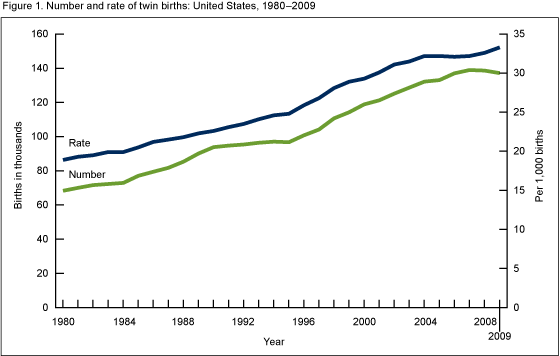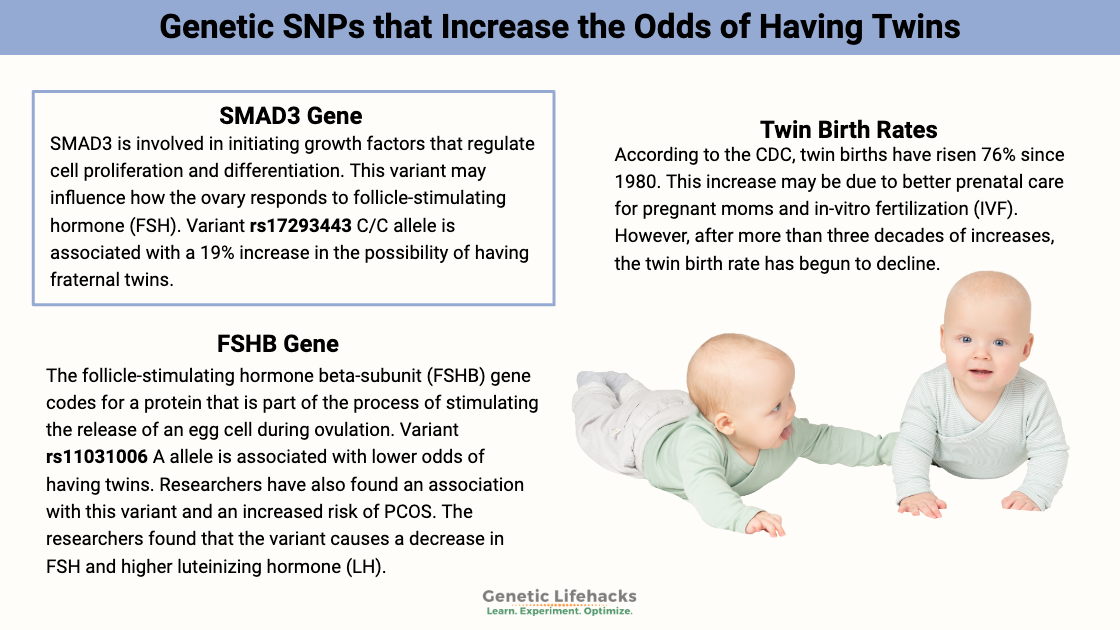Twins tend to ‘run in families’, which is a colloquial way of saying that there is a hereditary component that increases the likelihood of having twins. This quick article explains the genetic variants linked to the likelihood of having fraternal twins.
Twin Births:
According to the CDC, twin births have risen 76% since 1980. Estimates show that 1 in 30 babies born in the US are twins. (Keep in mind this doesn’t correspond to 1 in 30 pregnancies being twins since two babies being born skews the birthrate stats.)[ref] As a matter of fact, this increase is due to better prenatal care for pregnant moms. In-vitro fertilization (IVF) is also responsible for a portion of the increase. However, after more than three decades of increases, the twin birth rate has begun to decline. [ref]

So what does genetics have to do with twinning? There are a couple of genetic variants that increase the probability of having fraternal twins. It seems few or no genetic factors are involved in having identical twins.[ref]
Terminology:
Identical twins come from one fertilized egg that splits into two after fertilization. These are called monozygotic (one zygote).
Fraternal twins come from two different egg cells being released and fertilized. These are called dizygotic twins.
Fraternal Twins Genotype Report:
Lifehacks:
Not a lot of lifehacks here :-) Enjoy your blessings if you end up with twins.
One thing to note, rs11031006 (A/A genotype) shows an association with an increased risk of PCOS. The researchers found that the variant causes a decrease in FSH and higher luteinizing hormone (LH).[ref]
Related article: PCOS genes
Related Articles and Topics:
Dads matter: MTHFR variants in fathers affect miscarriage risk
Quite a few studies are showing that women carrying certain MTHFR variant combinations are at a somewhat higher risk for miscarriage, but I recently ran across a study that added a new twist to the topic. It turns out that the father’s MTHFR variants can also play a role in recurrent miscarriages.
Genetic links to infertility for women
Your genes may be playing a role in your infertility — and knowing which genetic variants you carry may help you figure out solutions to try.
Genetics, inflammatory cytokines, and recurrent miscarriage
Learn about how genetic variants in certain inflammatory cytokines can increase or decrease the risk of recurrent miscarriage.
References:
Day, Felix R., et al. “Causal Mechanisms and Balancing Selection Inferred from Genetic Associations with Polycystic Ovary Syndrome.” Nature Communications, vol. 6, no. 1, Sept. 2015, p. 8464. www.nature.com, https://doi.org/10.1038/ncomms9464.
Is the Probability of Having Twins Determined by Genetics?: MedlinePlus Genetics. https://medlineplus.gov/genetics/understanding/traits/twins/. Accessed 17 May 2022.
Mbarek, Hamdi, Stacy Steinberg, et al. “Identification of Common Genetic Variants Influencing Spontaneous Dizygotic Twinning and Female Fertility.” American Journal of Human Genetics, vol. 98, no. 5, May 2016, pp. 898–908. PubMed Central, https://doi.org/10.1016/j.ajhg.2016.03.008.
Mbarek, Hamdi, Conor V. Dolan, et al. “Two SNPs Associated With Spontaneous Dizygotic Twinning: Effect Sizes and How We Communicate Them.” Twin Research and Human Genetics: The Official Journal of the International Society for Twin Studies, vol. 19, no. 5, Oct. 2016, pp. 418–21. PubMed, https://doi.org/10.1017/thg.2016.53.

